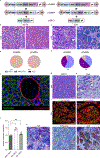Necroptosis microenvironment directs lineage commitment in liver cancer
- PMID: 30209397
- PMCID: PMC8111790
- DOI: 10.1038/s41586-018-0519-y
Necroptosis microenvironment directs lineage commitment in liver cancer
Erratum in
-
Author Correction: Necroptosis microenvironment directs lineage commitment in liver cancer.Nature. 2018 Dec;564(7735):E9. doi: 10.1038/s41586-018-0723-9. Nature. 2018. PMID: 30410124
Abstract
Primary liver cancer represents a major health problem. It comprises hepatocellular carcinoma (HCC) and intrahepatic cholangiocarcinoma (ICC), which differ markedly with regards to their morphology, metastatic potential and responses to therapy. However, the regulatory molecules and tissue context that commit transformed hepatic cells towards HCC or ICC are largely unknown. Here we show that the hepatic microenvironment epigenetically shapes lineage commitment in mosaic mouse models of liver tumorigenesis. Whereas a necroptosis-associated hepatic cytokine microenvironment determines ICC outgrowth from oncogenically transformed hepatocytes, hepatocytes containing identical oncogenic drivers give rise to HCC if they are surrounded by apoptotic hepatocytes. Epigenome and transcriptome profiling of mouse HCC and ICC singled out Tbx3 and Prdm5 as major microenvironment-dependent and epigenetically regulated lineage-commitment factors, a function that is conserved in humans. Together, our results provide insight into lineage commitment in liver tumorigenesis, and explain molecularly why common liver-damaging risk factors can lead to either HCC or ICC.
Conflict of interest statement
Figures















Comment in
-
Neighbourhood deaths cause a switch in cancer subtype.Nature. 2018 Oct;562(7725):45-46. doi: 10.1038/d41586-018-06217-3. Nature. 2018. PMID: 30275548 No abstract available.
-
Neighbourly deaths dictate fate.Nat Rev Cancer. 2018 Nov;18(11):665. doi: 10.1038/s41568-018-0064-x. Nat Rev Cancer. 2018. PMID: 30301932 No abstract available.
-
Bad neighborhoods: apoptotic and necroptotic microenvironments determine liver cancer subtypes.Hepatobiliary Surg Nutr. 2019 Aug;8(4):404-406. doi: 10.21037/hbsn.2019.03.20. Hepatobiliary Surg Nutr. 2019. PMID: 31489315 Free PMC article. No abstract available.
-
Viewpoint: necroptosis influences the type of liver cancer via changes of hepatic microenvironment.Hepatobiliary Surg Nutr. 2019 Oct;8(5):549-551. doi: 10.21037/hbsn.2019.04.15. Hepatobiliary Surg Nutr. 2019. PMID: 31673555 Free PMC article. No abstract available.
References
-
- Farazi PA & DePinho RA Hepatocellular carcinoma pathogenesis: from genes to environment. Nat. Rev. Cancer 6, 674–687 (2006). - PubMed
Publication types
MeSH terms
Substances
Grants and funding
LinkOut - more resources
Full Text Sources
Other Literature Sources
Medical
Molecular Biology Databases
Miscellaneous

